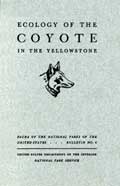.gif)
MENU
![]() Deer
Deer
|
Fauna of the National Parks — No. 4
Ecology of the Coyote in the Yellowstone |

|
CHAPTER VI:
MULE DEER IN RELATION TO COYOTES
BECAUSE fear had been expressed that coyote depredations on mule deer (Odocoileus hemionus macrotis), especially in winter, were so extensive that the future of the species in Yellowstone was threatened, I devoted much of my time during the winter of 1937—38 to a study of factors affecting the deer. Their food habits were studied in considerable detail, their range was carefully examined, competition of other ungulates noted, condition of deer watched, fatalities recorded and their causes and the age and sex of the dead animals determined when possible. Fawn survival through the winter was tabulated, coyote depredations noted, and general relationship between deer and coyotes was observed. Since the status of several other species was also involved and had to be studied, time did not permit me to go into details to the extent desired.

Figure 16— Browse line on Douglas fir along
the Yellowstone River above Blacktail Deer Creek: a typical condition
marking this a poor deer range.
March 21, 1938.
WINTER RANGE
MOST of the deer winter on the north side of the park in the following localities: Reese Creek, Game Ranch, lower reaches of the Gardiner River and Lava Creek, and along the Yellowstone River from Gardiner to Tower Falls. A few deer are found at Old Faithful, Norris, and occasionally at other isolated spots such as Cache Creek and Canyon. In 1937—38 deer were absent from some areas around Hellroaring Creek where they had wintered the previous year. The heavy crust on the snow in 1937—38 no doubt tended to restrict the winter range while the loose snow in the winter of 1936—37 had permitted the deer to spread out more freely. The deer move from the interior of the park to the winter range in the latter part of November and return in late May.
DEER AS COYOTE FOOD
DURING the winter, deer (in the form of carrion) furnish a varying supply of food for the coyotes. In some years rather heavy mortality among deer due to malnutrition and disease has been reported, while in other years the mortality has been light. In the latter part of the winter some fawns, chiefly the weaker ones, are killed by coyotes. Deer remains were found in 64 droppings gathered between March and November but many droppings noted in winter which were not recorded contained deer hair.

Figure 17— The Gardiner River, a short
distance below Lava Creek. This area has a heavy winter population of
deer. Cottonwoods and fir in the bottom: sage brush on the slopes.
March 25, 1938.
Continued >>>
 Top
Top
Last Modified: Thurs, Dec 20 2001 10:00:00 pm PDT
http://www.cr.nps.gov/history/online_books/fauna4/fauna6.htm
![]()
